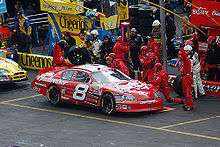Product displacement
Product displacement is the removing of trademarked products from primarily visual media in order to avoid the payment of licensing fees, if the trademark owner objects, or if the broadcaster would prefer not to publicise a product for free, if the owners have not paid for it to be included in a programme.[1]
Product displacement can also refer to brands/companies deliberately modifying their name or logo in an attempt to make people see the logo and realize that the logo/name is not correct. This extra thinking time forces people to register the real brand. This method can be more effective than product placement.[2]
Method
Product displacement is usually achieved via digital pixelation, though prior to the widespread availability of computer post-production, stagehands would cover up brands on bottles, etc., using tape, or by using fake labels. This was called "greeking"[3] and the term is also used now for the digital process as well.[1]
Types
There are two types of product displacements within the industry, which are identified as fictionalized and unbranded product displacements.
Fictionalized product displacement
Fictionalized product displacement is often used by directors or production staff to use a completely fictional brand and/or product which closely resembles and mimics a non-fictional product or brand. This is often done, so the viewers can make close correlation with an already existing non-fictional brand that they may use on a daily basis without having to create another fictional dimension for a separate product altogether. Some of the most popular TV series over the past decade have used this technique to allow their viewers to make that clear distinction, especially shows such as Scrubs where the protagonists are often seen mingling at a coffee shop known as "Coffee Bucks" which closely resembles the logo, colour and theme of a Starbucks. Similarly other TV shows such as My Name Is Earl also used similar technique with the fictional candy bar by the name of TitTat Candy, which closely resembles the Kit Kat chocolate bar, offered by The Hershey Company.[4]
Unbranded product displacement
Unbranded product displacement is used when a marketer makes a known effort to hide or pixelate the logo of non-fictional company or product within a specific advertisement, TV show, or movie. Within unbranded product displacement there are two different ways that can be used to hide or pixelate a non-fictional product or brand. Either through "digital alternation" where the brand is pixelated, erased, and or hid digitally, or through physical removal of a brand, such as removing the logo of a car from its front grill.[5]
Other notable examples

According to Danny Boyle, director of 2008 film Slumdog Millionaire, the makers had to resort to "product displacement" when companies such as Mercedes refused to allow their products to be used in non-flattering settings. They objected to their products been shown in a slum setting. This forced the makers in post-production to remove logos digitally, costing "tens of thousands of pounds".[6]
The practice of product displacement is also frequently seen on reality television programs which do not have clearance to display the logos or products of non-sponsor companies. This accounts for the frequent appearance of pixel mosaics and blurring of logo T-shirts, soda cans or bottles, and other instances on shows such as America's Next Top Model, Survivor, Dr. Phil, and The Real World.